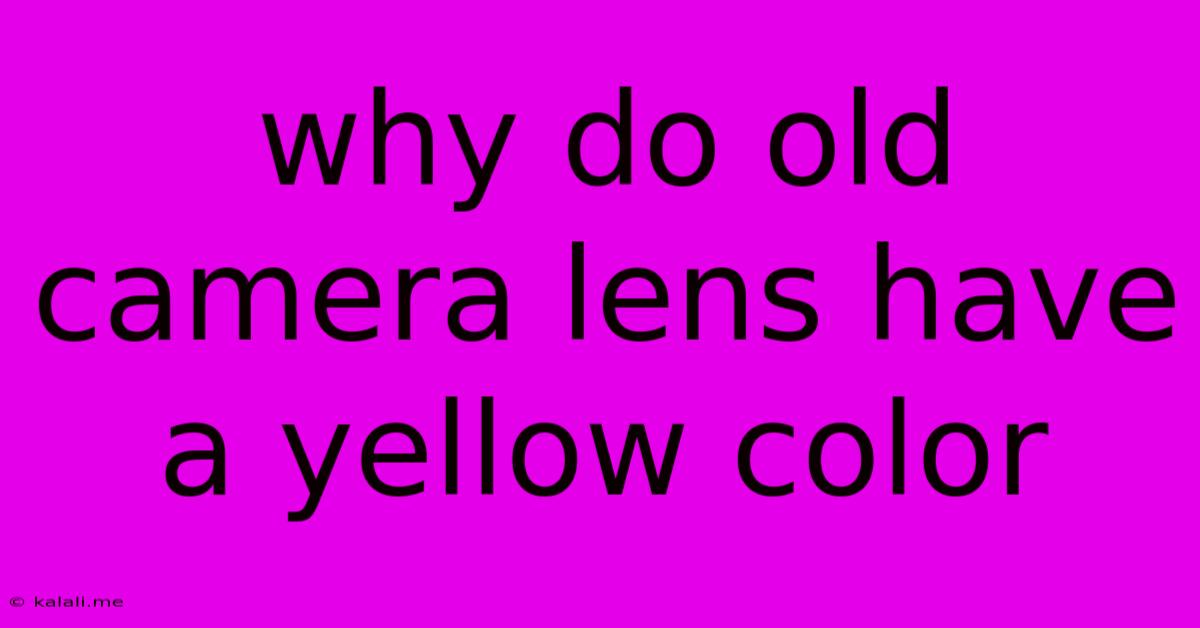Why Do Old Camera Lens Have A Yellow Color
Kalali
May 31, 2025 · 3 min read

Table of Contents
Why Do Old Camera Lenses Have a Yellow Tint? The Mystery of the Yellowed Lens
Have you ever noticed that many older camera lenses, especially those from the mid-20th century, often exhibit a yellowish or amber tint? This isn't a stylistic choice; it's a result of a fascinating chemical process that affects the lens elements over time. This article will delve into the science behind this phenomenon, exploring the causes and implications of yellowing in vintage camera lenses.
The Culprit: Degradation of the Lens Cement
The most common reason for yellowing in older lenses is the degradation of the adhesive used to bind the lens elements together. These older lenses often utilized a type of cement containing Canada balsam, a natural resin derived from the balsam fir tree. Over decades, this balsam, and other similar materials, undergoes a process of oxidation and polymerization, leading to the characteristic yellow hue. Think of it like how an old painting might darken or yellow with age – the same chemical processes are at play here.
Other Contributing Factors:
While Canada balsam is the primary suspect, other factors can contribute to lens yellowing:
-
UV Degradation: Prolonged exposure to ultraviolet (UV) light can break down the chemical bonds in the lens elements themselves, leading to discoloration. This is especially true for lenses made with certain types of glass.
-
Temperature Fluctuations: Extreme temperature changes and humidity can also accelerate the degradation process of the lens cement and the lens glass itself.
-
Storage Conditions: Improper storage, such as leaving lenses in direct sunlight or in damp conditions, can significantly impact their longevity and increase the likelihood of yellowing.
-
Type of Glass: Different types of glass used in lens construction possess varying degrees of susceptibility to UV degradation and other environmental factors.
Does Yellowing Affect Image Quality?
The impact of yellowing on image quality is a complex issue. While a slight yellow cast can often be corrected in post-processing, significant yellowing can introduce:
-
Color Cast: The most obvious effect is a general warmth or yellow tint across the entire image.
-
Reduced Contrast: Yellowing can subtly reduce contrast, making images appear less sharp and vibrant.
-
Potential for Haze: In severe cases, the yellowing might appear as a hazy or blurry effect, impacting image clarity.
Can You Reverse the Yellowing?
Unfortunately, reversing the yellowing process is rarely possible. While some attempts at cleaning or restoration have been suggested, these methods often carry the risk of damaging the delicate lens elements further. The yellowing is typically a result of chemical changes that are irreversible.
The Appeal of Yellowed Lenses:
Despite the potential drawbacks, many photographers appreciate the unique aesthetic quality of yellowed lenses. The subtle color shift and slightly reduced contrast can create a vintage or nostalgic look, adding a particular charm to photographs.
Conclusion:
The yellowing of old camera lenses is a fascinating consequence of the aging process of their materials, primarily the lens cement. Understanding the science behind this phenomenon helps us appreciate the history and unique character of these vintage optics. While it may affect image quality, the subtle yellowing often adds a distinct aesthetic that many photographers find desirable.
Latest Posts
Latest Posts
-
What Is Cud In The Bible
Jun 01, 2025
-
Car Heater Blows Hot Then Cold
Jun 01, 2025
-
Sum Of Two Uniform Random Variables
Jun 01, 2025
-
What Does U Stand For On A Circuti Board
Jun 01, 2025
-
How To Say Mommy In Japanese
Jun 01, 2025
Related Post
Thank you for visiting our website which covers about Why Do Old Camera Lens Have A Yellow Color . We hope the information provided has been useful to you. Feel free to contact us if you have any questions or need further assistance. See you next time and don't miss to bookmark.